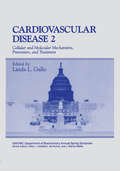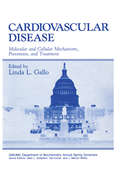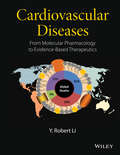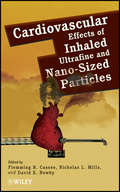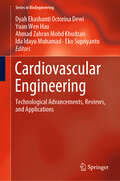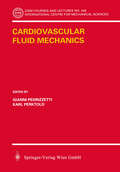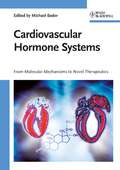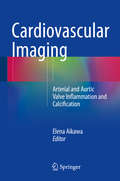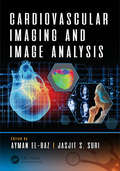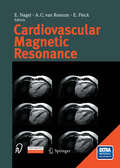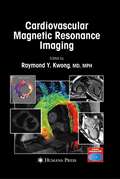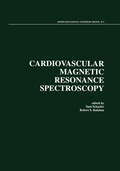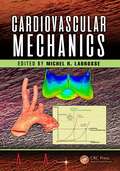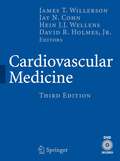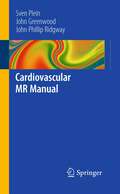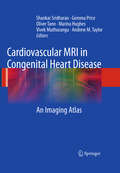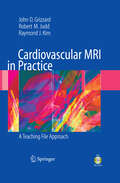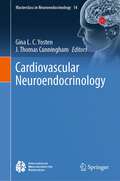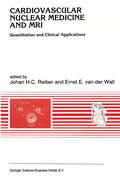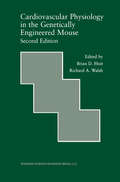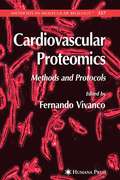- Table View
- List View
Cardiovascular Disease: Cellular and Molecular Mechanisms, Prevention, and Treatment (Gwumc Department of Biochemistry and Molecular Biology Annual Spring Symposia)
by Linda L. GalloThe Fourteenth Washington International Spring Symposium, held in Washington, D.C., in June 1994, brought together over 400 leading scientists from 21 countries to review and update research on cardiovascular disease. This group satisfied the symposium goals of formulating a more comprehensive and integrated picture of the events contributing to atherosclerosis and of exploring modified gene expression as an to understanding the causes of atherosclerosis and providing clues to the approach prevention and treatment. This volume contains most of the papers presented at the eight plenary sessions together with selected contributions from the special sessions. The multidisciplinary nature of the chapters and their authors should stimulate the interests of biochemists, cell and molecular biologists, pathologists, pharmacologists, epidemiologists, nutritionists, and clinicians. The volume is divided into eight sections which reflect the focus of the plenary sessions. Part I focuses on the pathophysiology of atherosclerotic plaques and predicts that the nature of the fibrous cap of atheroma determines plaque disruption and clinical events. Papers in Part II deal with atherogenic lipoproteins. The introductory paper reviews the current view of the role of plasma lipoproteins in atherosclerosis. With respect to the newer members on the list,: [oxidized LDL, Lp(a)] evidence is provided that suggests the involvement of one major gene in the development of oxidized LDL lipids. the expression of inflammatory genes, and the development of aortic fatty streaks.
Cardiovascular Disease: Molecular and Cellular Mechanisms, Prevention, and Treatment (Gwumc Department of Biochemistry and Molecular Biology Annual Spring Symposia)
by Linda L. GalloThe Sixth Annual International Spring Symposium on Health Sciences, held in Washington, D. C. , in May 1986, brought together over 650 scientists from 19 countries to review and update research on cardiovascular disease. In this volume, which contains 59 chapters, an internationally recognized group of authors con tribute up-to-date accounts of molecular and cellular processes occurring in the vessel wall in atherogenesis and describe approaches to the prevention and treatment of atherosclerosis. The volume is divided into six major sections. Two sections deal with current aspects of lipoprotein metabolism. In Part I, we are alerted to the impact on li poprotein metabolism of structural heterogeneity within the four broad lipoprotein classes. Attention then turns to the components that orchestrate lipoprotein metab olism. Apolipoprotein identities, processing, and functions are described, as are the roles of lipid transfer proteins in plasma lipoprotein remodeling. Hepatic lipase synthesis and secretion are described. In Part II, Nobel Laureates Michael S. Brown and Joseph L. Goldstein describe mutations in the LDL receptor that reveal the functions of its various domains and point out how understanding the LDL receptor has provided a rational basis for its regulation. A discussion of the role of receptors in regulating cholesterol uptake by tissues follows, with emphasis on receptor-ligand interactions. Additional pathways for cholesterol delivery to cells are explored, as are pathways for cholesterol egress.
Cardiovascular Diseases: From Molecular Pharmacology to Evidence-Based Therapeutics
by Y. Robert LiWritten in an accessible style and consistent format, the book covers both the fundamentals and advances in the pharmacology of cardiovascular drugs, as well as their integrated applications in the management of individual cardiovascular diseases. • Integrates fundamentals and recent advances regarding cardiovascular drugs, blending basic and clinical sciences needed to effectively understand and treat cardiovascular diseases • Facilitates understanding of drug action and mechanism by covering physiology / pathophysiology and pharmacology • Includes guidelines and algorithms for pharmacotherapeutic management of cardiovascular diseases • Uses case presentations and study questions to enhance understanding of the material • Serves as a resource for pharmaceutical and medical students and researchers interested in cardiovascular issues
Cardiovascular Diseases: From Molecular Pharmacology to Evidence-Based Therapeutics
by Y. Robert LiWritten in an accessible style and consistent format, the book covers both the fundamentals and advances in the pharmacology of cardiovascular drugs, as well as their integrated applications in the management of individual cardiovascular diseases. • Integrates fundamentals and recent advances regarding cardiovascular drugs, blending basic and clinical sciences needed to effectively understand and treat cardiovascular diseases • Facilitates understanding of drug action and mechanism by covering physiology / pathophysiology and pharmacology • Includes guidelines and algorithms for pharmacotherapeutic management of cardiovascular diseases • Uses case presentations and study questions to enhance understanding of the material • Serves as a resource for pharmaceutical and medical students and researchers interested in cardiovascular issues
Cardiovascular Effects of Inhaled Ultrafine and Nano-Sized Particles
by Flemming R. Cassee Nicholas L. Mills David E. NewbyThis book assists scientists, toxicologists, clinicians, and public health regulators to understand the complex issues that determine the impact of air pollution on the cardiovascular system. It covers a range of relevant topics including particulate matter (PM) sources and characterization, methods of exposure, impact of PM on cells and systems, role of particles in the pathophysiology of cardiovascular disease, risk assessment, and potential environmental and therapeutic interventions.
Cardiovascular Effects of Inhaled Ultrafine and Nano-Sized Particles
by Flemming R. Cassee Nicholas L. Mills David E. NewbyThis book assists scientists, toxicologists, clinicians, and public health regulators to understand the complex issues that determine the impact of air pollution on the cardiovascular system. It covers a range of relevant topics including particulate matter (PM) sources and characterization, methods of exposure, impact of PM on cells and systems, role of particles in the pathophysiology of cardiovascular disease, risk assessment, and potential environmental and therapeutic interventions.
Cardiovascular Engineering: Technological Advancements, Reviews, and Applications (Series in BioEngineering)
by Dyah Ekashanti Octorina Dewi Yuan Wen Hau Ahmad Zahran Mohd Khudzari Ida Idayu Muhamad Eko SupriyantoThis book highlights recent technological advances, reviews and applications in the field of cardiovascular engineering, including medical imaging, signal processing and informatics, biomechanics, as well as biomaterials. It discusses the use of biomaterials and 3D printing for tissue-engineered heart valves, and also presents a unique combination of engineering and clinical approaches to solve cardiovascular problems. This book is a valuable resource for students, lecturers and researchers in the field of biomedical engineering.
Cardiovascular Fluid Mechanics (CISM International Centre for Mechanical Sciences #446)
by Gianni Pedrizzetti Karl PerktoldThe book presents the state of the art in the interdisciplinary field of fluid mechanics applied to cardiovascular modelling. It is neither a monograph nor a collection of research papers, rather an extended review in the field. It is arranged in 4 scientific chapters each presenting thoroughly the approach of a leading research team; two additional chapters prepared by biomedical scientists present the topic by the applied perspective. A unique feature is a substantial (approx. one fourth of the book) medical introductory part, written by clinical researchers for scientific readers, that would require a large effort to be collected otherwise.
Cardiovascular Hormone Systems: From Molecular Mechanisms to Novel Therapeutics
by Michael BaderEdited by a renowned scientist in the field with more than 200 high profile scientific publications to his name, this is the first book to provide a comprehensive overview of all cardiovascular hormone systems. Clearly structured, the text covers steroid and peptide hormones, amines, and arachidonic acid metabolites, as well as such others as nucleotides, nitric oxide, and acetylcholine. An essential reference for researchers working on the cardiovascular system and related diseases.
Cardiovascular Imaging: Arterial and Aortic Valve Inflammation and Calcification
by Elena AikawaThis book provides comprehensive reviews on our most recent understanding of the molecular and cellular mechanisms underlying atherosclerosis and calcific aortic valve disease (CAVD) as visualized in animal models and patients using optical molecular imaging, PET-CT, ultrasound and MRI. In addition to presenting up-to-date information on the multimodality imaging of specific pro-inflammatory or pro-calcification pathways in atherosclerosis and CAVD, the book addresses the intriguing issue of whether cardiovascular calcification is an inflammatory disease, as has been recently supported by several preclinical and clinical imaging studies. In order to familiarize researchers and clinicians from other specialties with the basic mechanisms involved, chapters on the fundamental pathobiology of atherosclerosis and CAVD are also included. The imaging chapters, written by some of the foremost investigators in the field, are so organized as to reveal the nature of the involved mechanisms as disease progresses.
Cardiovascular Imaging and Image Analysis
by Ayman El-Baz Jasjit S. SuriThis book covers the state-of-the-art approaches for automated non-invasive systems for early cardiovascular disease diagnosis. It includes several prominent imaging modalities such as MRI, CT, and PET technologies. There is a special emphasis placed on automated imaging analysis techniques, which are important to biomedical imaging analysis of the cardiovascular system. Novel 4D based approach is a unique characteristic of this product. This is a comprehensive multi-contributed reference work that will detail the latest developments in spatial, temporal, and functional cardiac imaging. The main aim of this book is to help advance scientific research within the broad field of early detection of cardiovascular disease. This book focuses on major trends and challenges in this area, and it presents work aimed to identify new techniques and their use in biomedical image analysis. Key Features: Includes state-of-the art 4D cardiac image analysis Explores the aspect of automated segmentation of cardiac CT and MR images utilizing both 3D and 4D techniques Provides a novel procedure for improving full-cardiac strain estimation in 3D image appearance characteristics Includes extensive references at the end of each chapter to enhance further study
Cardiovascular Imaging and Image Analysis
by Ayman El-Baz Jasjit S. SuriThis book covers the state-of-the-art approaches for automated non-invasive systems for early cardiovascular disease diagnosis. It includes several prominent imaging modalities such as MRI, CT, and PET technologies. There is a special emphasis placed on automated imaging analysis techniques, which are important to biomedical imaging analysis of the cardiovascular system. Novel 4D based approach is a unique characteristic of this product. This is a comprehensive multi-contributed reference work that will detail the latest developments in spatial, temporal, and functional cardiac imaging. The main aim of this book is to help advance scientific research within the broad field of early detection of cardiovascular disease. This book focuses on major trends and challenges in this area, and it presents work aimed to identify new techniques and their use in biomedical image analysis. Key Features: Includes state-of-the art 4D cardiac image analysis Explores the aspect of automated segmentation of cardiac CT and MR images utilizing both 3D and 4D techniques Provides a novel procedure for improving full-cardiac strain estimation in 3D image appearance characteristics Includes extensive references at the end of each chapter to enhance further study
Cardiovascular Magnetic Resonance
by EckartFleck Albert C. Rossum EikeNagelMagnetic resonance imaging of the heart allows a quick and exact evaluation of global and regional pump function, regional myocardial wall motion, myocardial perfusion and coronary blood flow. Some of these parameters must also be analyzed under stress conditions to identify myocardial ischemia. By combining these functional parameters with high-resolution anatomical images, which are even sufficient to depict the coronary arteries, magnetic resonance imaging has become one of the most important noninvasive procedures to study the condition of the heart and is being increasingly used in the clinical setting. Therefore, it is important not only to optimize and evaluate the technique in specialized centers, but also for a broad variety of users to become familiar with the wide range of applications for this method. In this book, which is aimed at cardiologists, radiologists, and technical assistants, the physical fundamentals and scanning techniques are clearly described. In addition, practical guidelines for the anatomical planning of the examination and for patient care are offered. The accompanying CD-ROM contains additional figures and numerous videos.
Cardiovascular Magnetic Resonance Imaging (Contemporary Cardiology)
by Raymond Y. Kwong P. LibbyCardiac Magnetic Resonance Imaging (CMR) is a rapidly evolving tool. This book presents a state-of-the-art compilation of expert contributions to the field, each examining normal and pathologic anatomy of the cardiovascular system as assessed by magnetic resonance imaging. Functional techniques such as myocardial perfusion imaging and assessment of flow velocity are emphasized. The book represents a multi-disciplinary approach to the field.
Cardiovascular Magnetic Resonance Spectroscopy
by Robert S. Balaban SaulSchaeferThe application of magnetic resonance spectroscopy (MRS) to the cardiovascular system is a relatively new phenomenon. Its ability to noninvasively examine myocardial metabolism has led to its use to answer basic questions in animal models of normal and diseased myocardium. Extension of these investigations into the realm of human myocardial metabolism has been made possible by the advent of relatively high-field magnets with spectroscopy capabilities and sufficient bore dimensions to allow human studies. While ongoing and future studies promise to enhance our understanding of myocardial metabolism, their success will, in part, depend on a thorough understanding of the technical and biologic aspects of cardiovascular MRS, as well as the current state of research in the many areas encompassed by this discipline. It is with concept that the present monograph has been written. The organization and content should lend this book to both the beginning reader who is interested but not conversant in cardiovascular MRS, as well as to the active investigator who wishes to refer to a volume that deals with the many issues of this field in a concise but complete manner. The monograph is structured with a general overview of the field, followed by a section addressing the technical issues of cardiovascular MRS. The next section is devoted to biologic issues of both normal and abnormal myocardial metabolism, primarily devoted to investigations employing phosphorus-31. This is followed by a section dealing with more specialized issues, generally involving other nuclei such as protons, carbon, and sodium. Finally, the clinical applications of cardiovascular MRS are addressed.
Cardiovascular Mechanics
by Michel R. LabrosseThe objective of this book is to illustrate in specific detail how cardiovascular mechanics stands as a common pillar supporting such different clinical successes as drugs for high blood pressure, prosthetic heart valves and coronary artery bypass grafting, among others. This information is conveyed through a comprehensive treatment of the overarching principles and theories that are behind mechanobiological processes, aortic and arterial mechanics, atherosclerosis, blood and microcirculation, hear valve mechanics, as well as medical devices and drugs. Examines all major theoretical and practical aspects of mechanical forces related to the cardiovascular system. Discusses a unique coverage of mechanical changes related to an aging cardiovascular system. Provides an overview of experimental methods in cardiovascular mechanics. Written by world-class researchers from Canada, the US and EU. Extensive references are provided at the end of each chapter to enhance further study. Michel R. Labrosse is the founder of the Cardiovascular Mechanics Laboratory at the University of Ottawa, where he is a full professor within the Department of Mechanical Engineering. He has been an active researcher in academia along with being heavily associated with the University of Ottawa Heart Institute. He has authored or co-authored over 90 refereed communications, and supervised or co-supervised over 40 graduate students and post-docs.
Cardiovascular Mechanics
by Michel R. LabrosseThe objective of this book is to illustrate in specific detail how cardiovascular mechanics stands as a common pillar supporting such different clinical successes as drugs for high blood pressure, prosthetic heart valves and coronary artery bypass grafting, among others. This information is conveyed through a comprehensive treatment of the overarching principles and theories that are behind mechanobiological processes, aortic and arterial mechanics, atherosclerosis, blood and microcirculation, hear valve mechanics, as well as medical devices and drugs. Examines all major theoretical and practical aspects of mechanical forces related to the cardiovascular system. Discusses a unique coverage of mechanical changes related to an aging cardiovascular system. Provides an overview of experimental methods in cardiovascular mechanics. Written by world-class researchers from Canada, the US and EU. Extensive references are provided at the end of each chapter to enhance further study. Michel R. Labrosse is the founder of the Cardiovascular Mechanics Laboratory at the University of Ottawa, where he is a full professor within the Department of Mechanical Engineering. He has been an active researcher in academia along with being heavily associated with the University of Ottawa Heart Institute. He has authored or co-authored over 90 refereed communications, and supervised or co-supervised over 40 graduate students and post-docs.
Cardiovascular Medicine
by James T. Willerson Jay N. Cohn Hein J. J. Wellens David R. HolmesThis book offers the most up-to-date, user-friendly guidance on the evaluation, diagnosis and medical and surgical treatment of heart and vascular disease. The book and DVD package is designed to provide comprehensive coverage of every aspect of cardiovascular medicine. The book has consistent chapter organization relevant to modern cardiovascular practice, clear design and engaging text. The reader will have all the guidance to diagnose and manage the full range of cardiovascular conditions in one textbook resource, while also benefiting from access to additional video material from the integral DVD-ROM. This includes over 100 individual heart sounds.
Cardiovascular MR Manual
by Sven Plein John Greenwood John P RidgwayThe aim of this book is to provide a compact text for practicing physicians and cardiologists or radiologists in training that contains all aspects of cardiovascular magnetic resonance imaging relevant for the appropriate use of this imaging modality in clinical practice. In a tutorial style, the book provides an overview of the relevant physics that govern CMR imaging and provide details on commonly accepted indications for referral. The book also provides the necessary background information to get trainees prepared for training in a CMR center. The emphasis of the book will be on practical, hands-on information in a format small enough to be carried about for ease of use. The book will be a dense but extremely portable reference for all cardiologists involved in using or requesting MRI of their cardiac patients. This will be an all-in-one resource and of great clinical value.
Cardiovascular MRI in Congenital Heart Disease: An Imaging Atlas
by Shankar Sridharan Gemma Price Oliver Tann Marina Hughes Vivek Muthurangu Andrew M. TaylorThe last 10 years has seen explosive expansion of the number of centres performing cardiov- cular magnetic resonance (CMR) imaging. The majority of this expansion has been in the ? eld of adult ischaemic imaging, but congenital heart disease remains one of the main indications for CMR. Importantly, the greatly improved survival of patients with congenital heart disease gives us a burgeoning adult population living with the sequelae of the disease (grown-up c- genital heart disease – GUCH). Without previous experience or formal training, the interpretation of CMR images of patients with congenital heart disease can be dif? cult. The main aim of this book is to create a portable resource that offers ef? cient access to high-quality MR (and where appropriate, CT) images of the common congenital and structural heart abnormalities. We hope that by prov- ing key images for each condition and a clear interpretation of the MR appearances, we will improve the reader’s understanding of the conditions, facilitate their interpretation of images and optimise the planning of the imaging protocols during their own practice of congenital CMR. As with any publication from a single institution, the contents of this book represent our own practice. We have not written a de? nitive or exhaustive description of the conditions.
Cardiovascular MRI in Practice: A Teaching File Approach
by John Grizzard Robert Judd Raymond KimCardiovascular MR imaging has become a robust, clinically useful mod- ity, and the rapid pace of innovation and important information it conveys have attracted many students whose goal is to become adept practitioners. In turn, many excellent textbooks have been written to aid this process. These books are necessary and useful in helping the student learn the underlying pulse sequences used in CMR, as well as the imaging findings in a variety of disorders. However, one of the difficulties inherent in learning CMR from a book is that the printed format is not the ideal medium to d- play the dynamic imaging that comprises a typical CMR case. For instance, it may be difficult to perceive focal areas of wall motion abnormality on serial static pictures, but these abnormalities are often easily seen on cine loops. One might say that trying to learn CMR solely from a standard textbook with illustrations is like trying to learn to drive by looking at snapshots obtained through the windshield of a moving car. The learner needs to see the cardiac motion and decide if it is normal or abnormal; he or she needs to be in the driver’s seat. An additional limitation of the ava- able textbooks on CMR is that while they often have superb illustrations of abnormal findings, these images have been preselected.
Cardiovascular Neuroendocrinology (Masterclass in Neuroendocrinology #14)
by Gina L. C. Yosten J. Thomas CunninghamThe cardiovascular system and the neuroendocrine system are integrated at multiple levels. This integration is key to normal physiological function. Further, it adapts to accommodate changes related to aging, the organism’s reproductive state, or physiological challenges. This type of adaptability, or plasticity, also can contribute to pathophysiology when these systems are stressed. This volume discusses how neuroendocrine systems influence cardiovascular function in health and disease. The first section provides detailed background information on neuronal and neuroendocrine control of cardiovascular function. This is followed by chapters highlighting the cardiovascular role of neuroendocrine hormones in regulating physiological states, such as pregnancy, and the effects of biological sex on vascular function. The influence of exercise, stress, psychology, and aging on cardiovascular function and dysfunction, and the possibility of therapeutically targeting the neuroendocrine axis for the treatment of cardiovascular disease are discussed in the final section of the book.This book is of relevance for students, trainees and established researchers alike who are seeking for an overview on the neuroendocrine control of cardiovascular function and disease. This is the fourteenth volume in the International Neuroendocrine Federation (INF) Masterclass in Neuroendocrinology series, which aims to illustrate the highest standards and encourage the use of the latest technologies in basic and clinical research and hopes to provide inspiration for further exploration into the exciting field of neuroendocrinology.
Cardiovascular Nuclear Medicine and MRI: Quantitation and Clinical Applications (Developments in Cardiovascular Medicine #128)
by Johan H. C. Reiber Ernst E. Van Der WallIn recent years there have been major advances in the fields of cardiovascular nuclear medicine and cardiac magnetic resonance imaging. In nuclear cardiology more adequate tomographic systems have been designed for routine cardiac use, as well as new or improved quantitative analytic software packages both for planar and tomographic studies implemented on modern state-of-the-art workstations. In addition, artificial intelligence techniques are being applied to these images in attempts to interpret the nuclear studies in a more objective and reproducible manner. Various new radiotracers have been developed, such as antimyosin, labeled isonitriles, metabolic compounds, etc. Furthermore, alternative stress testing with dipyridamole and dobutamine has received much attention in clinical cardiac practice. Magnetic resonance imaging is a relative newcomer in cardiology and has already shown its merits, not only for anatomical information but increasingly for the functional aspects of cardiac performance. This book covers almost every aspect of quantitative cardiovascular nuclear medicine and magnetic resonance imaging. It will assist the nuclear medicine physician, the radiologist, the physicist/image processing specialist and the clinical cardiologist in understanding the nuclear medicine techniques used in cardiovascular medicine, and in increasing our knowledge of cardiac magnetic resonance imaging.
Cardiovascular Physiology in the Genetically Engineered Mouse (Developments in Cardiovascular Medicine #238)
by William H. Isbell Helaine SilvermanThe enormous advances in molecular biology and genetics coupled with the progress in instrumentation and surgical techniques have produced a voluminous and often bewildering quantity of data. The need for a second edition of Cardiovascular Physiology in the Genetically Engineered Mouse is underscored not only by these rapid advances, but by the increasing numbers of scientists who have focussed their research on genetically engineered mice. It is the primary objective of this second edition to interpret critically the literature and to provide a framework for the enormous amount of information in this burgeoning field. As in the first edition, the monograph serves as a practical guide for the investigator interested in the functional methods used to characterize the murine cardiovascular phenotype. However, this guidebook is a more comprehensive text than its predecessor; although the major objectives enumerated in the first edition have not substantially changed, they have been refined in keeping with the increased sophistication of the molecular biologist, geneticist, and physiologist in each other's discipline. Each chapter has been expanded and updated, richly enhanced with original tables and figures, and in many cases, extensively rewritten. Eight chapters written by internationally recognized experts have been added; this represents a 43 % increase from the first edition.
Cardiovascular Proteomics: Methods and Protocols (Methods in Molecular Biology #357)
by Fernando VivancoThis cutting-edge book presents protocols and strategies for proteomic evaluation of cardiovascular disease written by pioneering researchers in the field. Topics explored in this comprehensive volume include obtaining specific heart proteins, techniques for identifying risk biomarkers of atherome plaque rupture, analyzing the secretome of explanted endarterectomies cultured in vitro, and phage display techniques for deciphering the molecular diversity of blood vessels.
